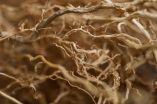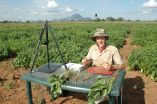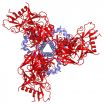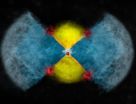(Press-News.org) Plant scientists are working to improve important food crops such as rice, maize, and beans to meet the food needs of a growing world population. However, boosting crop output will require improving more than what can be seen of these plants above the ground. Root systems are essential to gathering water and nutrients, but understanding what's happening in these unseen parts of the plants has until now depended mostly on lab studies and subjective field measurements.
To address that need, researchers from the Georgia Institute of Technology and Penn State University have developed an automated imaging technique for measuring and analyzing the root systems of mature plants. The technique, believed to be the first of its kind, uses advanced computer technology to analyze photographs taken of root systems in the field. The imaging and software are designed to give scientists the statistical information they need to evaluate crop improvement efforts.
"We've produced an imaging system to evaluate the root systems of plants in field conditions," said Alexander Bucksch, a postdoctoral fellow in the Georgia Tech School of Biology and School of Interactive Computing. "We can measure entire root systems for thousands of plants to give geneticists the information they need to search for genes with the best characteristics."
The research is supported by the National Science Foundation's Plant Genome Research Program (PGRP) and Basic Research to Enable Agriculture Development (BREAD), the Howard Buffett Foundation, the Burroughs Wellcome Fund and the Center for Data Analytics at Georgia Tech. The research was reported as the cover story in the October issue of the journal Plant Physiology.
Beyond improving food crops, the technique could also help improve plants grown for energy production, materials, and other purposes.
Root systems are complicated and vary widely even among plants of the same species. Analyzing critical root properties in field-grown plants has depended on manual measurements, which vary with observer. In contrast, automated measurements have the potential to provide enhanced statistical information for plant improvement.
Imaging of root systems has, until now, largely been done in the laboratory, using seedlings grown in small pots and containers. Such studies provide information on the early stages of development, and do not directly quantify the effects of realistic growing conditions or field variations in water, soil, or nutrient levels.
The technique developed by Georgia Tech and Penn State researchers uses digital photography to provide a detailed image of roots from mature plants in the field.
Individual plants to be studied are dug up and their root systems washed clean of soil. The roots are then photographed against a black background using a standard digital camera pointed down from a tripod. A white fabric tent surrounding the camera system provides consistent lighting.
The resulting images are then uploaded to a server running software that analyzes the root systems for more than 30 different parameters – including the diameter of tap roots, root density, the angles of brace roots, and detailed measures of lateral roots. Scientists working in the field can upload their images at the end of a day and have spreadsheets of results ready for study the next day.
"In the lab, you are just seeing part of the process of root growth," said Bucksch, who works in the group of Associate Professor Joshua Weitz in the School of Biology and School of Physics at Georgia Tech. "We went out to the field to see the plants under realistic growing conditions."
Developing the digital photography technique required iterative refinements to produce consistent images that could be analyzed using computer programs. To support the goal of making the system available worldwide, it had to be simple enough for field researchers to use consistently, able to be transported in backpacks to locations without electricity, and built on inexpensive components.
In collaboration with a research team led by Jonathan Lynch, a professor of plant sciences at Penn State, the system has been evaluated in South Africa with cowpea and maize plants. With its ability to quickly gather data in the field, it was possible to evaluate a complete cowpea diversity panel. Penn State collaborator James Burridge compiled a novel cowpea reference data set that consists of approximately 1,500 excavated root systems.
The data set was measured manually to validate and compare with the new computational approaches. In the future, the system could allow scientists to study crop roots over an entire growing season, potentially providing new life cycle data.
The research shows how quantitative measurement techniques from one discipline can be applied to other areas of science.
"Alexander has taken rigorous, computational principles and collaborated with leading plant root biologists from the Lynch group to study complex root structure under field conditions," said Weitz. "In doing so, he has shown how automated methods can reveal new below-ground traits that could be targeted for breeding and improvement."
Data generated by the new technique will be used in subsequent analyses to help understand how changes in genetics affect plant growth. For instance, certain genes may help plants survive in nitrogen-poor soils, or in areas where drought is a problem. The overall goal is to develop improved plants that can feed increasing numbers of people and provide sustainable sources of energy and materials.
"We have to feed an ever-growing population and we have to replace materials like oil-based fuels," Bucksch said. "Integral to this change will be understanding plants and how they provide us with food and alternative materials. This imaging technique provides data needed to accomplish this."
INFORMATION:
In addition to those already mentioned, the research team included Larry York and Eric Nord from Penn State and Abraham Das from Georgia Tech.
This research was supported by NSF Plant Genome Research Program Award 0820624, the NSF/BREAD Program Award 4184-UM-NSF-5380, the Howard G. Buffett Foundation, the Center for Data Analytics at Georgia Tech, and the Burroughs Wellcome Fund. Any opinions or conclusions are those of the authors and do not necessarily represent the official views of the funding agencies.
Citation: Alexander Bucksch, et al, "Image-based high-throughput field phenotyping of crop roots," (Plant Physiology 2014). http://dx.doi.org/10.1104/pp.114.243519
Lebanon, NH, 10/8/14 —To reduce false positives when identifying genetic variations associated with human disease through genome-wide association studies (GWAS), Dartmouth researchers have identified nine traits that are not dependent on P values to predict single nucleotide polymorphisms (SNP) reproducibility as reported in Human Genetics on October 2, 2014.
Reproducibility rates of SNPs based solely on P values is low. Dartmouth authors' analysis of GWAS studies published in Nature Genetics showed a 1-5 percent replication rate.
"It is important to improve our ...
A new study from UCLA found that a drug being evaluated to treat an entirely different disorder helped slow the progression of Parkinson's disease in mice.
The study, published in the October edition of the journal Neurotherapeutics, found that the drug, AT2101, which has also been studied for Gaucher disease, improved motor function, stopped inflammation in the brain and reduced levels of alpha-synuclein, a protein critically involved in Parkinson's.
Although the exact cause of Parkinson's is unknown, evidence points to an accumulation of alpha-synuclein, which has ...
Astronomers working with NASA's Nuclear Spectroscopic Telescope Array (NuSTAR), led by Caltech's Fiona Harrison, have found a pulsating dead star beaming with the energy of about 10 million suns. The object, previously thought to be a black hole because it is so powerful, is in fact a pulsar—the incredibly dense rotating remains of a star.
"This compact little stellar remnant is a real powerhouse. We've never seen anything quite like it," says Harrison, NuSTAR's principal investigator and the Benjamin M. Rosen Professor of Physics at Caltech. "We all thought an ...
ATLANTA – October 08, 2014 – A study from American Cancer Society researchers finds the increased risk of premature death associated with a higher body mass index (BMI) is similar for African Americans and whites, in contrast to previous, smaller studies that indicated the association may be weaker for African Americans. The study, published in the open-access, online publication PLOS ONE, finds that among never smokers without prevalent disease, overweight and obesity are strongly associated with subsequent risk of mortality in every race. The authors say ...
New Haven, Conn. - HIV is adept at eluding immune system responses because the protein it uses to infect cells is constantly changing.
Now a team of researchers including scientists from Yale have stripped the cloak from this master of disguise, providing a high resolution image of this surface spike protein and monitoring how it constantly changes its shape, information that suggests new ways to attack the virus through drugs and vaccines.
In two papers published simultaneously online Oct. 8 in the journals Science and Nature. team of researchers led by scientists ...
Highly-detailed radio-telescope images have pinpointed the locations where a stellar explosion called a nova emitted gamma rays, the most energetic form of electromagnetic waves. The discovery revealed a probable mechanism for the gamma-ray emissions, which mystified astronomers when first observed in 2012.
"We not only found where the gamma rays came from, but also got a look at a previously-unseen scenario that may be common in other nova explosions," said Laura Chomiuk, of Michigan State University.
A nova occurs when a dense white dwarf star pulls material onto ...
New research has illuminated the movement and complete structure of the spikes on HIV that the virus uses to bind to the cells it infects. This research, led by scientists at the National Institutes of Health, Weill Cornell Medical College and Yale University School of Medicine, could help advance efforts to develop HIV vaccines and treatments.
Three sets of a pair of molecules called gp120 and gp41 constitute each HIV spike, which adopts different configurations before and after the virus fuses with a cell. The atomic-level structures of pre-fusion gp120 and post-fusion ...
NEW YORK — (October 8, 2014) -- Researchers at Weill Cornell Medical College have developed technologies that allow investigators, for the first time, to watch what they call the "dance" of HIV proteins on the virus' surface, which may contribute to how it infects human immune cells. Their discovery is described in the Oct. 8 issue of Science, and is also a part of a study published the same day in Nature.
The new technology platform opens new possibilities for devising an approach to prevent HIV infection, says Dr. Scott Blanchard, an associate professor of physiology ...
Astronomers have discovered a black hole that is consuming gas from a nearby star 10 times faster than previously thought possible. The black hole—known as P13—lies on the outskirts of the galaxy NGC7793 about 12 million light years from Earth and is ingesting a weight equivalent to 100 billion billion hot dogs every minute.
The discovery was published today in the journal Nature.
International Centre for Radio Astronomy Research astronomer Dr Roberto Soria, who is based at ICRAR's Curtin University node, said that as gas falls towards a black hole it gets ...
An international team of astronomers has been able to see into the heart of an exploding star, by combining data from telescopes that are hundreds or even thousands of kilometres apart. Their results are published at 18:00 hours on Oct 8 2014 in the journal Nature.
Highly-detailed images produced using radio telescopes from across Europe and America have pinpointed the locations where a stellar explosion (called a nova), emitted gamma rays (extremely high energy radiation). The discovery revealed how the gamma-ray emissions are produced, something which mystified astronomers ...






